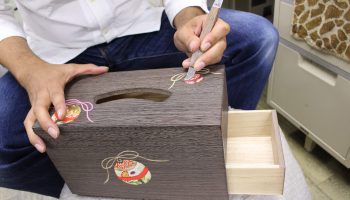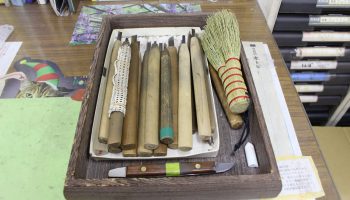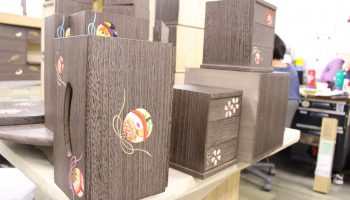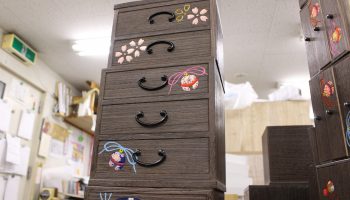Kiri-Kogei [ Paulownia Craftwork ]
Miyata Kenji
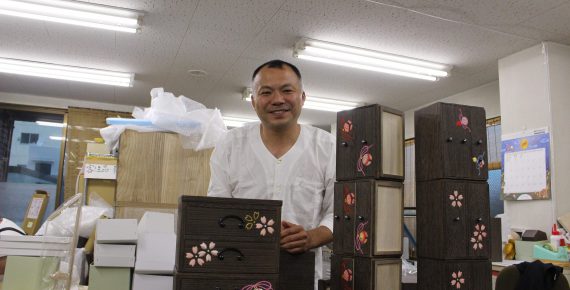
Mr. Kenji Miyata is the representative director of Hakocho, where they make and sell paulownia kimekomi zaiku merchandise.
Paulownia kimekomi zaiku craftsmanship refers to tansu cabinets and wooden boxes made of paulownia wood that have lucky patterns and designs, such as bells and gourds, carved into them and decorated with pieces of antique kimono fabric. The history of paulownia crafts dates back to the Edo Period (1603-1868) but paulownia kimekomi zaiku is an original technique created at Hakocho during the Meiji Period (1868-1912). The idea originated with the standard tansu cabinet used by brides when they left their families to start new lives, but the kimekomi zaiku added an extra touch of luxury and beauty. Nowadays, they have branched out from only tansu cabinets to include a wide range of interior decorations perfect for every home.
The process of creating paulownia kimekomi zaiku begins with selecting paulownia wood and making it into a tansu cabinet or interior accessory. Next, the design is carved into the wood. This process is called ‘Sujibori’ or line engraving. After that, the line engraving is made more three-dimensional by carving into it on a slant, a process called ‘Saraibori’. Then, a triangular chisel is used to dig out grooves in a process called ‘Yagenbori’. After that the grooves are painted in a range of colours and pieces of fabric cut to match the design are glued into place using a special tool to complete ‘Kimekomi’.
Mr. Kenji Miyata briefly worked a regular job in order to get a better understanding of the world around him but after a year and a half he returned to follow in the family business.
From a young age he often helped out and knew that one day he would succeed as a craftsman.
Mr. Kenji Miyata has recently been putting in a lot of effort into training young people.
In 2006, he began employing graduates of technical high schools and is currently training 5 young people.
“The reason I decided to make an effort in training others is because paulownia kimekomi zaiku is an original technique and I thought that we needed to produce more craftsmen. A workplace filled with young people is full of energy, we can learn a lot about current trends from them, and it’s also very motivating.” Mr. Kenji Miyata said.
He also added that his general feeling is that customers these days like to carefully select merchandise. It’s not that they are looking for inexpensive products, but rather, it appears that the number of customers who want something that is good quality even if it’s expensive is increasing.
“I feel my work is worthwhile when I finish making a product and the customer is thrilled with it. It’s very important for craftsmen to make good quality products but there’s no greater bliss than to see the delight on a customer’s face when they are truly pleased with the product they received.
From now on I want to continue training young people and also enhance our facilities, such as our location and equipment.
Finally, I hope we will be able to be a group of craftsmen who have won the approval of our customers not with our price but with the quality of our hand-made products.”
Short ver.
Long ver.
(If you would like to know more about the craft history, manufacturing process, tools, etc., please check this movie.)
Hakocho Co., Ltd.
Address: (Tokyo) Taito, Kotobuki 1-4-5 (shop on Orange Street)
Telephone: 03-3843-8719
